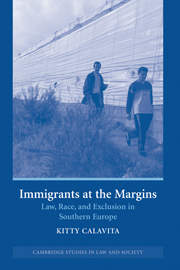Book contents
- Frontmatter
- Contents
- List of tables
- Preface
- Acknowledgments
- Maps
- 1 Introduction
- 2 Legal framework and the wayward “legs of law”
- 3 “Useful invaders”: the economics of alterité
- 4 Integrating the “Other”
- 5 The Everyday dynamics of exclusion: work, health, and housing
- 6 Fuel on the fire: politics, crime, and racialization
- 7 Conclusion: immigrants and other strangers in the global marketplace
- Notes
- Bibliography
- Index
2 - Legal framework and the wayward “legs of law”
Published online by Cambridge University Press: 04 July 2009
- Frontmatter
- Contents
- List of tables
- Preface
- Acknowledgments
- Maps
- 1 Introduction
- 2 Legal framework and the wayward “legs of law”
- 3 “Useful invaders”: the economics of alterité
- 4 Integrating the “Other”
- 5 The Everyday dynamics of exclusion: work, health, and housing
- 6 Fuel on the fire: politics, crime, and racialization
- 7 Conclusion: immigrants and other strangers in the global marketplace
- Notes
- Bibliography
- Index
Summary
Spain and Italy are often referred to as new countries of immigration. In this portrayal, they are culturally homogeneous national communities experiencing an influx of culturally and ethnically diverse populations for the first time. But of course the reverse is more historically accurate. For one thing, the territories of Spain and Italy have long been the stage for invasions, migration, and ethnic mixing; furthermore, in the case of Italy, the status of nation is a relatively recent achievement.
By the time Italy was established as a republic in the 1860s, it had witnessed more, and more diverse, population influxes than perhaps any other place in Europe. People from Asia Minor – later to become Etruscans – landed on the Tuscan coast in the tenth century BC; the Greeks colonized Sicily and eventually much of the rest of southern Italy two centuries later; Phoenician traders migrated into Sardinia during the same period; Carthaginians landed on the southern coast of Sicily in the sixth century BC; Gauls crossed the Alps in the fifth century BC; nine hundred years later, as the Roman Empire was being dismantled, the Visigoths made the same journey across the Alps; in the ninth century, Arabs took over Sicily, a perennial target; Normans conquered southern Italy and Sicily in the eleventh century; and the fifteenth and sixteenth centuries brought invasions from both the French and the Spanish.
- Type
- Chapter
- Information
- Immigrants at the MarginsLaw, Race, and Exclusion in Southern Europe, pp. 22 - 47Publisher: Cambridge University PressPrint publication year: 2005

